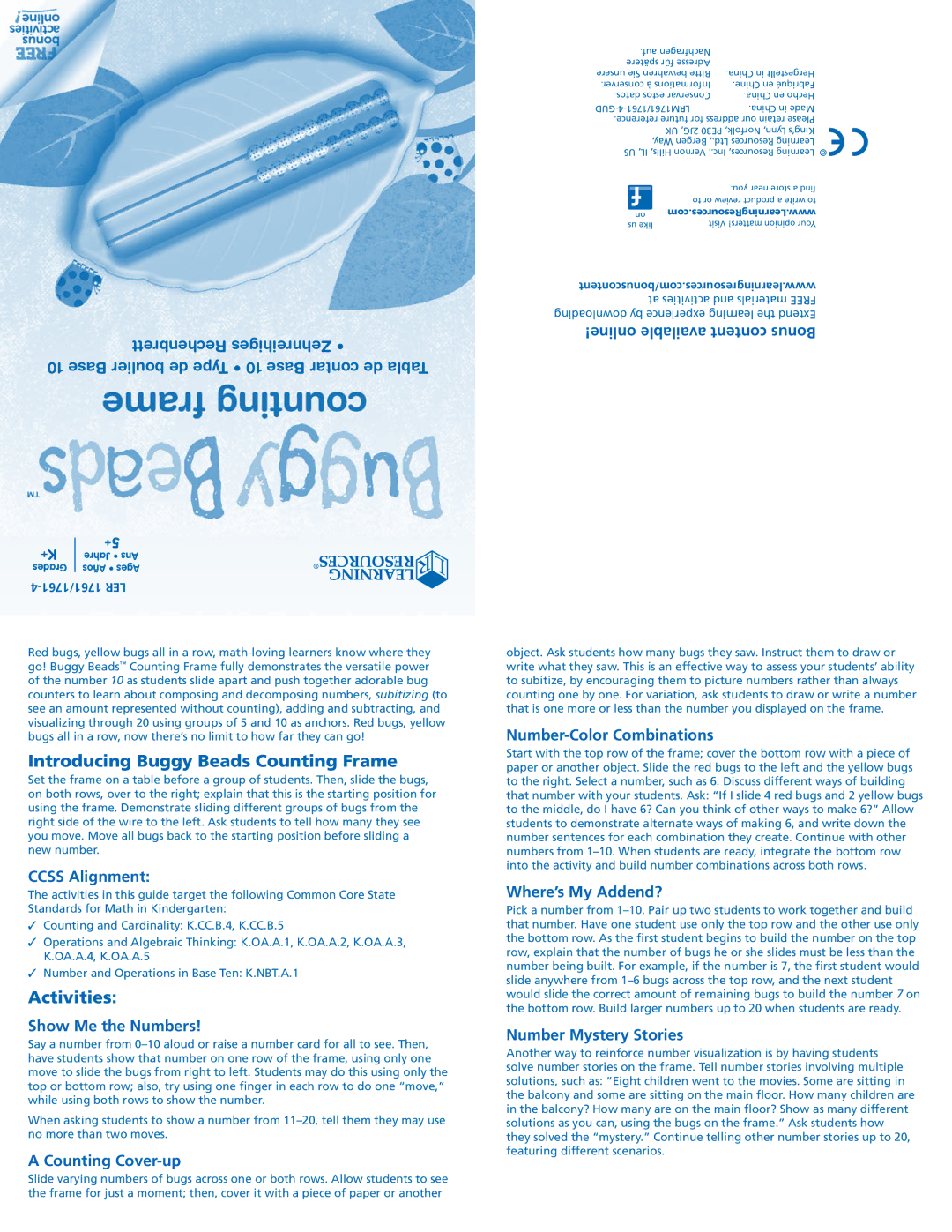
RechenbrettFPOZehnreihiges • 10 Base boulier de Type • 10 Base contar de Tabla
Frame Counting ™Beads Buggy
K+ Jahre5+• Ans
Grades AñosAges• Ages
4-1761/1761 LER
1761 LER
Red bugs, yellow bugs all in a row,
Introducing Buggy Beads Counting Frame
Set the frame on a table before a group of students. Then, slide the bugs, on both rows, over to the right; explain that this is the starting position for using the frame. Demonstrate sliding different groups of bugs from the right side of the wire to the left. Ask students to tell how many they see you move. Move all bugs back to the starting position before sliding a new number.
CCSS Alignment:
The activities in this guide target the following Common Core State Standards for Math in Kindergarten:
3Counting and Cardinality: K.CC.B.4, K.CC.B.5
3Operations and Algebraic Thinking: K.OA.A.1, K.OA.A.2, K.OA.A.3, K.OA.A.4, K.OA.A.5
3Number and Operations in Base Ten: K.NBT.A.1
Activities:
Show Me the Numbers!
Say a number from
When asking students to show a number from
A Counting Cover-up
Slide varying numbers of bugs across one or both rows. Allow students to see the frame for just a moment; then, cover it with a piece of paper or another
| .auf Nachfragen |
| ||
spätere für Adresse |
| |||
unsere Sie bewahren Bitte | .China in Hergestellt | |||
.conserver à Informations | .Chine en Fabriqué | |||
.datos estos Conservar | .China en Hecho | |||
.China in Made | ||||
.reference future for address our retain Please | ||||
|
|
| UK 2JG, PE30 Norfolk, Lynn, King’s | |
|
| Way, Bergen ,.Ltd Resources Learning | ||
US IL, Hills, Vernon ,.Inc Resources, Learning © | ||||
|
|
|
| .you near store a find |
|
|
|
| |
|
|
| to or review product a write to | |
| on | com.LearningResources.www | ||
us like | Visit matters! opinion Your | |||
com/bonuscontent.learningresources.www at activities and materials FREE downloading by experience learning the Extend
online! available content Bonus
object. Ask students how many bugs they saw. Instruct them to draw or write what they saw. This is an effective way to assess your students’ ability to subitize, by encouraging them to picture numbers rather than always counting one by one. For variation, ask students to draw or write a number that is one more or less than the number you displayed on the frame.
Number-Color Combinations
Start with the top row of the frame; cover the bottom row with a piece of paper or another object. Slide the red bugs to the left and the yellow bugs to the right. Select a number, such as 6. Discuss different ways of building that number with your students. Ask: “If I slide 4 red bugs and 2 yellow bugs to the middle, do I have 6? Can you think of other ways to make 6?” Allow students to demonstrate alternate ways of making 6, and write down the number sentences for each combination they create. Continue with other numbers from
Where’s My Addend?
Pick a number from
Number Mystery Stories
Another way to reinforce number visualization is by having students solve number stories on the frame. Tell number stories involving multiple solutions, such as: “Eight children went to the movies. Some are sitting in the balcony and some are sitting on the main floor. How many children are in the balcony? How many are on the main floor? Show as many different solutions as you can, using the bugs on the frame.” Ask students how they solved the “mystery.” Continue telling other number stories up to 20, featuring different scenarios.
